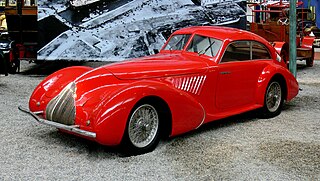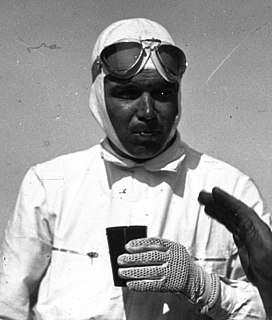The Grand Prix du Comminges was an automobile race held in France.
The race was named after the Comminges, one of the former Provinces of France in ancient Gascony in what is now the Haute-Garonne department of the Midi-Pyrénées region of France. The race began as part of a week-long festival organized by local officials in the town of Saint-Gaudens designed to attract tourists.
Grand Prix motor racing was at its zenith when the first race was first held in 1925 on a 27 km (17 mi) course from Saint-Gaudens to the town of Montréjeau and back again via a different route. The hilly terrain allowed for excellent viewing close to the beginning and end of the race from atop a hill at the outskirts of Saint-Gaudens. In 1926, the French Grand Prix was held here over a slightly altered course and in the 1930s, the course layout was modified a few times beginning with changes made to accommodate holding the official French Grand Prix in 1928.
At the 1932 race René Dreyfus was leading in his Bugatti going into the final lap. Rain fell and on the wet road he spun out on a sharp curve. Dreyfus was thrown from the vehicle as it somersaulted through the air but suffered only minor injuries. However, his car hurtled directly towards a large group of spectators gathered off to the side of the road but hit a small tree and smashed to the ground without injuring anyone.
Due to a controversy over vehicle regulations, both the 1937 and 1938 races had to be cancelled when major factory teams boycotted the event. After World War II, the creation of Formula One saw the Grand Prix du Comminges modified to a Formula Two event but, with the top drivers no longer competing, economics dictated cancellation after the 1952 race.

Louis Alexandre Chiron was a Monégasque racing driver who competed in rallies, sports car races, and Grands Prix.

Philippe Étancelin was a French Grand Prix motor racing driver who joined the new Formula One circuit at its inception.

The Alfa Romeo 8C was originally a range of Alfa Romeo road, race and sports cars of the 1930s. In 2004 Alfa Romeo revived the 8C name for a V8-engined concept car which made it into production for 2007, the 8C Competizione.

Guillaume Laurent "Guy" Moll was a French racing driver.

The Alfa Romeo P3, P3 monoposto or Tipo B was a classic Grand Prix car designed by Vittorio Jano, one of the Alfa Romeo 8C models. The P3 was first genuine single-seat Grand Prix racing car and Alfa Romeo's second monoposto after Tipo A monoposto (1931). It was based on the earlier successful Alfa Romeo P2. Taking lessons learned from that car, Jano went back to the drawing board to design a car that could last longer race distances.

Formula Libre, also known as Formule Libre, is a form of automobile racing allowing a wide variety of types, ages and makes of purpose-built racing cars to compete "head to head". This can make for some interesting matchups, and provides the opportunity for some compelling driving performances against superior machinery. The name translates to "Free Formula" – in Formula Libre races the only regulations typically govern basics such as safety equipment.

The 1935 Grand Prix season was the second year of the new 750 kg Formula. The success of the previous year encouraged the AIACR to reinitiate the European Championship. It was composed of the seven national Grands Prix and was won by Rudolf Caracciola, driving for the Mercedes-Benz team. The team dominated the season winning five of those Grand Épreuves, as well as four of the other major races of the season. However, in one of the great motor-races in sporting history, Tazio Nuvolari in a Scuderia Ferrari Alfa Romeo beat the combined numbers of the German teams in their home Grand Prix. The season also saw the arrival on the international stage of the bright young talent Bernd Rosemeyer in the Auto Union team.

The 1931 Grand Prix season was a watershed year, with the advent of the AIACR European Championship. After several years of Grand Prix racing in the doldrums with little technical development, 1931 saw new models come from all three main manufacturers: Bugatti, Maserati and Alfa Romeo.

The 1932 Grand Prix season marked the second year of the AIACR European Championship. It saw the debut of Alfa Romeo's sensational new Tipo B and with it, Tazio Nuvolari won the Championship driving for the Alfa Corse works team. The 40-year old Nuvolari won two of the three rounds and was second in the other. Still running to a Formula Libre rules for the cars, the regulations were revised to set the races to be between five and ten hours. However, all three national committees ran their races to the minimum time-limit.

The 1933 Grand Prix season was an intermediate year, as it would be the last season for the current AIACR regulations before a new weight-formula was introduced in 1934. As such, the European Championship was not held and the manufacturers held back on further developments of their existing models. Alfa Romeo, following an Italian government financial bailout and like Mercedes-Benz the previous year, had shut down its Alfa Corse works team. Scuderia Ferrari, their regular customer team took up the role of racing Alfa Romeos and a number of ex-works drivers moved across to join their ranks. They were not allowed, however, to buy the impressive Tipo B that had been so dominant in the previous season.
The 1934 Grand Prix season saw the advent of the new 750 kg Formula. In an effort to curb the danger of rising speeds, the AIACR imposed this upper weight limit that effectively outlawed the large capacity engines. The incumbent manufacturers Alfa Romeo, Maserati and Bugatti had been preparing their new models with varying success – the best of which was the Alfa Romeo Tipo B. However, it was the state-sponsored arrival of the two German teams, Mercedes-Benz and Auto Union, and their innovative and progressive cars that ignited a new, exciting era of motor racing.

The Maserati Tipo 26M was a model of Grand Prix race car produced by Italian manufacturer Maserati in Bologna, for a total of 13 units, between 1930 and 1932.

The 1928 Grand Prix season saw the Monegasque driver Louis Chiron, and his Bugatti, take seven Grand Prix victories.

Luigi Arcangeli was an Italian motorcycle and car racer.
The 1929 Grand Prix season was another interim year, where most races were run to Formula Libre rules due to a lack of regulations from the AIACR that would be popular for race organisers and manufacturers. This blurred the line between racing cars and sports cars with both competing in the same races. Bugatti won the major international races, with their drivers Louis Chiron and "W Williams". The Italian Championship proved very competitive, attracting many top drivers. There it was Alfa Romeo, using their 4-year old P2 model that claimed more victories, than their main competition coming from Bugatti and Maserati.
The 1930 Grand Prix season continued the malaise that had taken over the sport. Although there was little technical advance more privateer teams were forming, getting some factory support. The AIACR continued to mandate its fuel-regulated Formula Libre rules. Across the Atlantic, the AAA abandoned the AIACR regulations. Their new regulations were derisively called the “Junk Formula” by purists, opening up to their own version of Formula Libre: with modified stock-standard cars of up to 366 cu in (6-litres) with two seats.

The Tunis Grand Prix or Grand Prix de Tunis was a motor race held in the 1920s and 30s in Tunis, the capital of the African colony of the French protectorate of Tunisia.

The 1933 French Grand Prix was a Grand Prix motor race which was run on 11 June 1933, in Montlhéry, France. Organized by the French Automobile Club, it was XXVII running of the Grand Prix de l'Automobile Club de France. The race, which was held over 40 laps, was won by the Italian driver Giuseppe Campari in a privately entered Maserati. It was to be Campari's final victory, as he was killed just three months later at Monza. Philippe Étancelin and George Eyston, both in privateer Alfa Romeos, finished in second and third, respectively.

The 1930 Monza Grand Prix was a Grand Prix motor race held at the Autodromo Nazionale di Monza on 7 September 1930. There were four 14-lap heats, a 7-lap repêchage, and a 35-lap final, which was won by Achille Varzi in a Maserati. His teammates, Luigi Arcangeli and Ernesto Maserati, completed the podium.
The Algerian Grand Prix or Grand Prix d'Alger was a motor race held in the 1920s and 1930s at several coastal road courses in the department of French Algeria.
 M Goury (Bignan B)
M Goury (Bignan B) Louis Chiron (Bugatti T35)
Louis Chiron (Bugatti T35) François Eysermann (Bugatti T37)
François Eysermann (Bugatti T37) William Grover-Williams (Bugatti T35C)
William Grover-Williams (Bugatti T35C) Philippe Étancelin (Bugatti T35C)
Philippe Étancelin (Bugatti T35C) François Miquel (Bugatti T37A)
François Miquel (Bugatti T37A) Philippe Étancelin (Alfa Romeo 8C 2300 'Monza')
Philippe Étancelin (Alfa Romeo 8C 2300 'Monza') Goffredo Zehender (Alfa Romeo 8C 2300 'Monza')
Goffredo Zehender (Alfa Romeo 8C 2300 'Monza') Luigi Fagioli (Alfa Romeo Tipo-B 'P3')
Luigi Fagioli (Alfa Romeo Tipo-B 'P3') Franco Comotti (Alfa Romeo Tipo-B 'P3')
Franco Comotti (Alfa Romeo Tipo-B 'P3') Raymond Sommer (Alfa Romeo Tipo-B 'P3')
Raymond Sommer (Alfa Romeo Tipo-B 'P3') Jean-Pierre Wimille (Bugatti T59/57)
Jean-Pierre Wimille (Bugatti T59/57) René Le Bègue (Talbot MD90)
René Le Bègue (Talbot MD90) Louis Chiron (Talbot Monoplace C39)
Louis Chiron (Talbot Monoplace C39) Luigi Villoresi (Maserati 4CLT/48)
Luigi Villoresi (Maserati 4CLT/48) Charles Pozzi (Delahaye 145)
Charles Pozzi (Delahaye 145) André Simon /
André Simon /  Alberto Ascari (Ferrari Tipo 500)
Alberto Ascari (Ferrari Tipo 500)














